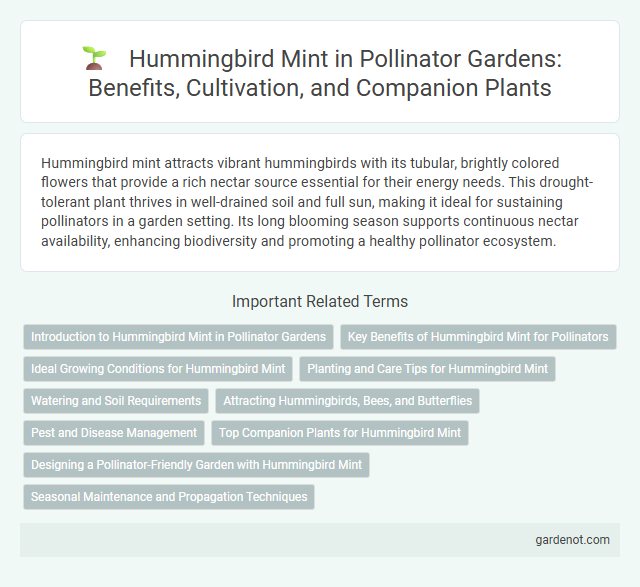Hummingbird mint attracts vibrant hummingbirds with its tubular, brightly colored flowers that provide a rich nectar source essential for their energy needs. This drought-tolerant plant thrives in well-drained soil and full sun, making it ideal for sustaining pollinators in a garden setting. Its long blooming season supports continuous nectar availability, enhancing biodiversity and promoting a healthy pollinator ecosystem.
Introduction to Hummingbird Mint in Pollinator Gardens
Hummingbird mint (Agastache spp.) is a vibrant addition to pollinator gardens, renowned for its nectar-rich flowers that attract hummingbirds and a variety of pollinating insects. Its aromatic leaves and tubular blooms provide essential food sources throughout the growing season, supporting biodiversity and enhancing garden health. This drought-tolerant perennial thrives in well-drained soil and full sun, making it an ideal choice for sustainable pollinator-friendly landscapes.
Key Benefits of Hummingbird Mint for Pollinators
Hummingbird mint attracts diverse pollinators, including hummingbirds, bees, and butterflies, with its vibrant, tubular flowers rich in nectar. Its extended blooming season provides a reliable food source, supporting pollinator health and biodiversity throughout spring to fall. The plant's drought tolerance and low maintenance qualities offer sustainable habitat benefits in pollinator gardens within various climates.
Ideal Growing Conditions for Hummingbird Mint
Hummingbird mint thrives in full sun to partial shade, requiring well-drained soil with moderate moisture for optimal growth. This drought-tolerant perennial prefers temperatures between 65degF and 85degF and benefits from regular pruning to encourage dense foliage and prolonged blooming. Planting hummingbird mint in gardens with good air circulation helps prevent fungal diseases, making it a resilient and attractive addition to pollinator gardens.
Planting and Care Tips for Hummingbird Mint
Plant Hummingbird mint (Agastache species) in well-draining soil with full sun exposure to ensure vibrant blooms that attract pollinators. Water regularly but allow the soil to dry between watering sessions to prevent root rot, especially during hot summer months. Prune spent flowers and thin out older stems in early spring to promote healthy growth and prolonged flowering throughout the season.
Watering and Soil Requirements
Hummingbird mint (Agastache species) thrives in well-draining soil with moderate fertility, preferring sandy or loamy textures that prevent waterlogging. Regular watering is essential during the initial growth phase, ensuring the soil remains consistently moist but not soggy, while established plants tolerate moderate drought conditions. Maintaining proper soil moisture supports vigorous blooming and attracts pollinators like hummingbirds and bees to the pollinator garden.
Attracting Hummingbirds, Bees, and Butterflies
Hummingbird mint (Agastache spp.) is a vibrant perennial renowned for its nectar-rich flowers that attract hummingbirds, bees, and butterflies, making it a vital component of pollinator gardens. Its tubular blossoms provide an accessible food source for hummingbirds' long beaks while also offering abundant nectar for native bees and butterflies like monarchs and swallowtails. Planting hummingbird mint supports biodiversity by promoting pollinator activity and enhancing garden ecosystems with its aromatic leaves and extended blooming season.
Pest and Disease Management
Hummingbird mint (Agastache spp.) is generally resistant to common pests but can occasionally suffer from aphids, spider mites, and powdery mildew. Effective pest and disease management includes regular inspection of foliage, encouraging beneficial insects like ladybugs, and using organic insecticidal soaps when necessary. Proper spacing and watering at the base reduce humidity, minimizing fungal infections and promoting healthy growth.
Top Companion Plants for Hummingbird Mint
Hummingbird mint thrives alongside vibrant companion plants such as bee balm, salvia, and coneflowers, which attract a diverse range of pollinators, including hummingbirds and butterflies. These companion plants complement hummingbird mint by providing extended bloom periods and varied flower shapes, enhancing the garden's pollinator appeal. Incorporating native grasses and aromatic herbs like lavender further supports pollinator health while creating a visually dynamic and fragrant habitat.
Designing a Pollinator-Friendly Garden with Hummingbird Mint
Hummingbird mint (Agastache spp.) thrives in pollinator gardens due to its vibrant tubular flowers and strong fragrance that attract hummingbirds and bees. Incorporating hummingbird mint in sunny, well-drained garden beds enhances nectar availability and supports pollinator diversity throughout the growing season. Planting it alongside native wildflowers and providing water sources creates an inviting habitat that promotes healthy pollinator populations.
Seasonal Maintenance and Propagation Techniques
Hummingbird mint requires regular seasonal pruning in late winter to promote vigorous growth and abundant flowering through spring and summer. Propagation is most effective through softwood cuttings taken in early summer or by division in early spring, ensuring vigorous new plants. Consistent watering and well-drained soil enhance root development and overall plant health for optimal pollinator attraction.
Hummingbird mint Infographic

 gardenot.com
gardenot.com